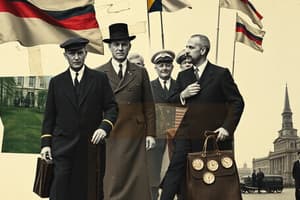Podcast
Questions and Answers
What was the primary reason for naming the Weimar Republic after the town of Weimar?
What was the primary reason for naming the Weimar Republic after the town of Weimar?
- It was the capital of Germany during that period.
- It was known for its peacefulness compared to Berlin. (correct)
- It had a strong Jewish community.
- It was where the Kaiser lived.
How many coalition governments were formed in the Weimar Republic between 1919 and 1933?
How many coalition governments were formed in the Weimar Republic between 1919 and 1933?
- Ten
- Twenty (correct)
- Twenty-five
- Fifteen
Who was the first chancellor of the Weimar Republic?
Who was the first chancellor of the Weimar Republic?
- Friedrich Ebert (correct)
- General Ludendorff
- Otto von Bismarck
- Erich Ludendorff
What was one of the consequences of the proportional voting system in the Weimar Republic?
What was one of the consequences of the proportional voting system in the Weimar Republic?
What did Article 48 of the Weimar Constitution allow the President to do?
What did Article 48 of the Weimar Constitution allow the President to do?
What was the 'stab-in-the-back legend'?
What was the 'stab-in-the-back legend'?
Which financial obligation did Germany face after WW1 as a result of the Versailles Treaty?
Which financial obligation did Germany face after WW1 as a result of the Versailles Treaty?
What was the role of the Reichstag in the Weimar Republic?
What was the role of the Reichstag in the Weimar Republic?
Flashcards
Weimar Republic
Weimar Republic
The period of German history from 1919 to 1933, characterized by a series of coalition governments and political instability.
Proportional voting
Proportional voting
Voting system that leads to many parties and difficulty forming a majority government in Weimar Germany.
Coalition government
Coalition government
A government formed by multiple political parties.
Chancellor
Chancellor
Signup and view all the flashcards
Article 48
Article 48
Signup and view all the flashcards
Stab-in-the-Back Legend
Stab-in-the-Back Legend
Signup and view all the flashcards
Reparations
Reparations
Signup and view all the flashcards
Reichstag
Reichstag
Signup and view all the flashcards
Study Notes
Weimar Republic
- The Weimar Republic was the name for Germany's government from 1919 to 1933.
- It was named for the town of Weimar, where the constitution was created.
- The Weimar Republic experienced widespread disillusionment and collapse of morale after World War I.
- Military defeats led to strikes and dissent, including the refusal of sailors at the Kiel naval base to fight the British.
- Kaiser Wilhelm II abdicated and fled to the Netherlands.
Key Government Features
- Twenty separate coalition governments led to instability, with no single party holding a majority.
- The shortest coalition governments lasted a mere two years.
- Germany's parliamentary system, the Reichstag, handled law-making and oversight.
- A proportional voting system contributed to the multitude of parties and unstable governments.
Key Figures
- Friedrich Ebert was the first Chancellor and leader of the Social Democratic Party (SPD). He was not Jewish.
- General Ludendorff, a key figure in WWI, blamed the Weimar Republic for the 'stab-in-the-back' legend and joined the Nazi Party.
- The 'stab-in-the-back' legend falsely blamed politicians, socialists, communists, trade unionists, and Jews for Germany's defeat.
Essential Concepts
- Chancellor: The head of government, comparable to a prime minister.
- President: Elected every 7 years.
- Article 48: Allowed the president emergency powers to rule by decree.
- Proportional Voting: This voting system led to numerous parties, complicating the formation of a stable government.
- Coalition: A government formed by multiple parties working together which was common.
Weimar Economic and Political Challenges
- Reparations: Harsh terms of the Treaty of Versailles demanded large financial payments from Germany, igniting resentment and economic hardship.
- Hyperinflation: Rampant inflation caused by the printing of money to meet reparation obligations, eroding the value of German currency. The Great Depression (starting in 1929) and the collapse of the stock market had a negative impact, causing severe unemployment in Germany.
- Unstable Political Climate: Multiple rebellions (left-wing and right-wing) plagued the Weimar Republic. Germany lacked a history of democracy and was accustomed to strong leadership.
Studying That Suits You
Use AI to generate personalized quizzes and flashcards to suit your learning preferences.




